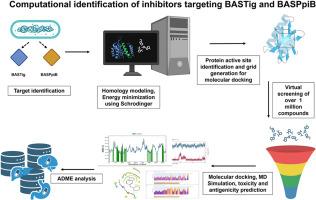基于结构的炭疽芽孢杆菌触发因子和肽基脯氨酸顺/反式异构酶B (PpiB)小分子抑制剂的鉴定:探索新的炭疽治疗干预措施
IF 3
4区 生物学
Q2 BIOCHEMICAL RESEARCH METHODS
引用次数: 0
摘要
由炭疽芽孢杆菌引起的炭疽病仍然是一种严重的人畜共患威胁,随着感染的晚期进展和抗生素耐药性的增加,治疗效果日益受到影响。本研究利用综合计算策略,从炭疽杆菌中识别和表征以前未表征的分子伴侣-触发因子(BASTig)和肽基脯氨酸顺式反式异构酶B (BASPpiB)-新的治疗靶点。利用同源性建模和AlphaFold进行结构解析,揭示了BASTig(425个残基)和BASPpiB(145个残基)的独特结构。多种化学文库的高通量虚拟筛选确定化合物51002和50423为有前景的抑制剂,其结合亲和力分别为-52.58和-66.4 kcal/mol。ADME分析证实了有利的药物样性质,分子动力学模拟证明了稳定的蛋白质配体相互作用。量子力学计算进一步支持了这些配合物的电子互补性和热力学稳定性。静电表面电位(ESP)分析表明,化合物51002具有主要的正电荷分布,有利于与BASTig中的酸性残基相互作用,而化合物50423具有非均质静电区,能够自适应结合BASPpiB的动态口袋。毒性预测表明两种铅的安全性都是可以接受的。免疫原性评估显示差异抗原潜力(BASPpiB: 100%, BASTig: 66%)。ABCpred表位定位在两种蛋白中发现了多个高分的、空间分布的b细胞表位,预测算法之间具有很大的一致性。这些结果突出了靶向分子伴侣治疗炭疽杆菌的前景,为小分子药物的发现和合理的免疫原设计提供了基础,解决了炭疽干预和抗微生物药物耐药性的迫切需求。本文章由计算机程序翻译,如有差异,请以英文原文为准。

Structure-based identification of small molecule inhibitors targeting trigger factor and peptidyl prolyl cis/trans isomerase B (PpiB) of Bacillus anthracis Sterne: Towards new therapeutic interventions against anthrax
Anthrax, caused by Bacillus anthracis, remains a critical zoonotic threat, with treatment efficacy increasingly compromised by advanced infection progression and rising antibiotic resistance. This study leverages integrative computational strategies to identify and characterize novel therapeutic targets among previously uncharacterized molecular chaperones-Trigger Factor (BASTig) and peptidyl-prolyl cis-trans isomerase B (BASPpiB)-from B. anthracis Sterne. Structural elucidation using homology modelling and AlphaFold revealed distinctive architectures for BASTig (425 residues) and BASPpiB (145 residues). High-throughput virtual screening of diverse chemical libraries pinpointed compounds 51002 and 50423 as promising inhibitors, with strong binding affinities of −52.58 and −66.4 kcal/mol, respectively. ADME profiling confirmed favourable drug-like properties, and molecular dynamics simulations demonstrated stable protein–ligand interactions. Quantum mechanical calculations further supported the electronic complementarity and thermodynamic stability of these complexes. Electrostatic surface potential (ESP) analysis revealed that compound 51002 features predominantly positive charge distributions, favouring interactions with acidic residues in BASTig, while compound 50423 displays heterogeneous electrostatic regions, enabling adaptive binding to BASPpiB's dynamic pocket. Toxicity predictions indicated acceptable safety profiles for both leads. Immunogenicity assessment showed differential antigenic potential (BASPpiB: 100 %, BASTig: 66 %). Epitope mapping with ABCpred identified multiple high-scoring, spatially distributed B-cell epitopes in both proteins, with substantial concordance between predictive algorithms. These results highlight the therapeutic promise of targeting molecular chaperones in B. anthracis and provide a foundation for both small-molecule drug discovery and rational immunogen design, addressing urgent needs in anthrax intervention and antimicrobial resistance.
求助全文
通过发布文献求助,成功后即可免费获取论文全文。
去求助
来源期刊

Journal of molecular graphics & modelling
生物-计算机:跨学科应用
CiteScore
5.50
自引率
6.90%
发文量
216
审稿时长
35 days
期刊介绍:
The Journal of Molecular Graphics and Modelling is devoted to the publication of papers on the uses of computers in theoretical investigations of molecular structure, function, interaction, and design. The scope of the journal includes all aspects of molecular modeling and computational chemistry, including, for instance, the study of molecular shape and properties, molecular simulations, protein and polymer engineering, drug design, materials design, structure-activity and structure-property relationships, database mining, and compound library design.
As a primary research journal, JMGM seeks to bring new knowledge to the attention of our readers. As such, submissions to the journal need to not only report results, but must draw conclusions and explore implications of the work presented. Authors are strongly encouraged to bear this in mind when preparing manuscripts. Routine applications of standard modelling approaches, providing only very limited new scientific insight, will not meet our criteria for publication. Reproducibility of reported calculations is an important issue. Wherever possible, we urge authors to enhance their papers with Supplementary Data, for example, in QSAR studies machine-readable versions of molecular datasets or in the development of new force-field parameters versions of the topology and force field parameter files. Routine applications of existing methods that do not lead to genuinely new insight will not be considered.
 求助内容:
求助内容: 应助结果提醒方式:
应助结果提醒方式:


